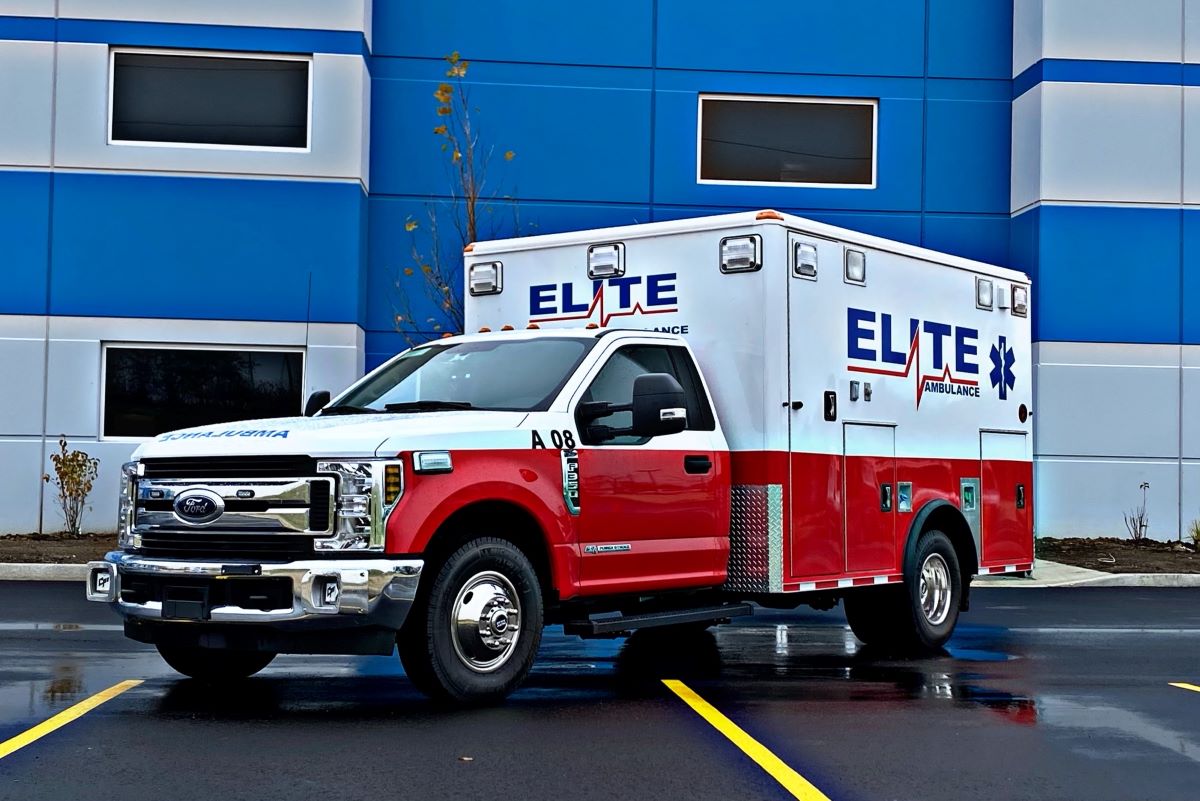Home>Finance>How Much Is An Ambulance Ride Without Insurance In California


Finance
How Much Is An Ambulance Ride Without Insurance In California
Published: November 21, 2023
"Learn about the cost of ambulance rides in California without insurance and find out how to manage your finances in the event of an emergency."
(Many of the links in this article redirect to a specific reviewed product. Your purchase of these products through affiliate links helps to generate commission for LiveWell, at no extra cost. Learn more)
Table of Contents
- Introduction
- Overview of Ambulance Services in California
- Factors Affecting Ambulance Ride Costs
- Local Government Assistance Programs
- Private Insurance Coverage
- Medi-Cal (California’s Medicaid Program)
- Cash Payments and Financing Options
- Nonprofit Organizations Providing Financial Assistance
- Cost Comparison: Ambulance Services in Different California Regions
- Conclusion
Introduction
Emergency medical services are an essential part of our healthcare system, providing life-saving care and transportation during critical incidents. One of the most crucial components of emergency medical services is the ambulance service, which plays a vital role in ensuring timely and safe transportation of patients to medical facilities.
In California, ambulance rides without insurance can be quite expensive, making it crucial for individuals to understand the costs and potential financial assistance options available to them. Without insurance coverage, the burden of ambulance costs can fall on the patient or their family, potentially leading to significant financial strain.
This article aims to provide an in-depth understanding of how much an ambulance ride without insurance can cost in California. We will explore various factors that influence ambulance ride costs and the options available for financial assistance. Whether you are a California resident or planning a visit to the state, knowledge about ambulance services and their associated costs is essential.
Understanding the intricacies of ambulance ride costs and exploring alternative payment options can help individuals make informed decisions and minimize any unexpected financial burdens. Let’s dive into the details and explore how much an ambulance ride without insurance can cost in California.
Overview of Ambulance Services in California
When emergencies strike, ambulance services in California are responsible for providing immediate medical attention and transportation to individuals in need. California has a well-developed network of ambulance service providers, including both private companies and public entities.
These ambulance services are typically equipped with highly trained paramedics and emergency medical technicians (EMTs) who can administer essential medical treatment on-site and during the transportation process. The primary goal of ambulance services is to stabilize patients and transport them to the most appropriate medical facility based on their condition.
In California, ambulance services are categorized into two types: Basic Life Support (BLS) and Advanced Life Support (ALS). BLS ambulances are staffed with EMTs, while ALS ambulances have paramedics on board who can provide a higher level of medical care. The level of care required depends on the patient’s condition and the distance to the nearest medical facility.
It is important to note that ambulance services in California operate on a fee-for-service basis, which means that individuals are billed for the services provided. The cost of an ambulance ride can vary depending on several factors, including the distance traveled, level of care required, and the specific provider.
Furthermore, California has a tiered system for determining the appropriate level of care and transportation for patients. For example, a patient with a life-threatening condition such as a heart attack or severe trauma may require a higher level of care and will be transported via an ALS ambulance. On the other hand, a patient with a less severe condition or one who needs transportation for non-urgent reasons may be transported via a BLS ambulance.
Now that we have a general understanding of ambulance services in California, let’s explore the factors that can influence the cost of an ambulance ride without insurance in the state.
Factors Affecting Ambulance Ride Costs
Several factors can influence the cost of an ambulance ride without insurance in California. It is important to be aware of these factors to better understand the potential expenses involved.
1. Distance Traveled: The distance traveled plays a significant role in determining the cost of an ambulance ride. Generally, the longer the distance, the higher the cost. Ambulance services often charge per mile, so the total mileage covered during transportation will impact the overall expense.
2. Level of Care Required: The level of medical care needed can also affect the cost. ALS ambulances, which have paramedics on board, can provide a higher level of care and may be more expensive than BLS ambulances staffed with EMTs. The specific medical interventions performed during the ride, such as administering medication or performing advanced procedures, can also influence the cost.
3. Urgency of the Situation: The urgency of the situation can impact the cost as well. Emergency or urgent cases may incur additional charges compared to non-emergency transportation. Emergency cases often require a faster response time and immediate medical attention, which can contribute to higher costs.
4. Additional Services: Some ambulance services may provide additional services that can increase the overall cost. For example, specialized transport for patients requiring a stretcher or wheelchair may come with added charges. Additionally, if specific equipment or supplies are needed during transportation, it can affect the final cost.
5. Provider and Location: The specific ambulance service provider and the location of the ride can also influence the cost. Different providers may have varying rates, and the cost can vary depending on the region within California. Urban areas may have different pricing structures compared to rural areas, due to factors such as demand, availability, and operating costs.
It is important to note that while these factors play a role in determining the cost of an ambulance ride, they can vary from one situation to another. Additionally, ambulance services may have their own unique fee schedules and billing processes. Therefore, it is crucial to consult with the respective ambulance service provider directly to obtain accurate and up-to-date information on pricing.
Next, let’s explore the options available for financial assistance with ambulance ride costs in California.
Local Government Assistance Programs
In California, local government assistance programs may be available to help individuals cover the costs of an ambulance ride, particularly for those who are uninsured or facing financial hardship.
1. Emergency Medical Services (EMS) Fund: Some counties in California have established EMS funds to help individuals who are unable to pay for emergency medical services, including ambulance rides. These funds are typically supported by local taxes or other sources of revenue and are intended to provide financial relief for those in need. Eligibility criteria and the level of assistance provided may vary depending on the county.
2. Local indigent programs: Some counties offer indigent programs that provide financial assistance to low-income individuals without insurance. These programs aim to ensure that all residents have access to emergency medical services, including ambulance rides. Individuals may be required to meet specific income and asset eligibility requirements to qualify for this assistance.
3. County Medical Services Program (CMSP): CMSP is a state-administered program that provides medical and health-related assistance to uninsured individuals in participating counties. While CMSP does not directly cover ambulance ride costs, it may help individuals access other forms of healthcare that could potentially alleviate the need for emergency transportation.
4. Non-Emergency Medical Transportation (NEMT) Services: Some counties offer NEMT services for individuals who require non-emergency medical transportation, such as transportation to medical appointments or specialized treatments. These services may be provided at a reduced cost or free of charge for eligible individuals. While not specifically for ambulance rides, NEMT services can be an alternative for those seeking transportation assistance.
To determine eligibility and access local government assistance programs, individuals should reach out to their county’s social services department or healthcare agency. These agencies can provide detailed information about the available programs, application procedures, and any specific requirements.
It’s important to note that the availability and coverage of local government assistance programs can vary from county to county in California. Therefore, individuals should research and inquire about the programs specific to their location to determine the extent of financial support they may receive.
Next, let’s explore the role of private insurance in covering ambulance ride costs.
Private Insurance Coverage
Private health insurance plans often offer coverage for ambulance services, including the cost of an ambulance ride. If you have private health insurance, it is essential to understand your policy’s coverage details to determine whether ambulance costs are included and to what extent.
When considering private insurance coverage for ambulance services, here are some key points to keep in mind:
1. In-Network Providers: Private insurance plans typically have a network of preferred providers, including ambulance services. It is important to ensure that the ambulance service you choose is in-network with your insurance provider to maximize coverage. Using an out-of-network provider may result in higher out-of-pocket expenses.
2. Coverage Criteria: Private insurance plans may have specific criteria for ambulance coverage. Generally, coverage is more likely when an ambulance ride is deemed medically necessary due to a severe or life-threatening condition. Non-emergency or transportation for convenience purposes may have limited or no coverage.
3. Copayments and Deductibles: Your insurance plan may require you to pay a copayment or meet a deductible before coverage for ambulance services kicks in. It is important to review your policy to understand these cost-sharing requirements and how they affect your financial responsibility.
4. Prior Authorization: Some insurance plans may require prior authorization before approving coverage for an ambulance ride. It is crucial to check with your insurance provider in advance to determine if such authorization is necessary and to follow the required procedures to avoid any coverage denials.
5. Billing and Claims Process: Familiarize yourself with the billing and claims process for ambulance services with your insurance provider. Understanding how to properly submit claims and what documentation is required can help facilitate a smoother reimbursement process.
It is essential to review your insurance policy documents or contact your insurance provider directly to obtain comprehensive information about your specific coverage for ambulance services. This will allow you to make informed decisions and be prepared financially for potential ambulance ride costs.
Next, let’s explore the role of Medi-Cal, California’s Medicaid program, in providing coverage for ambulance rides.
Medi-Cal (California’s Medicaid Program)
Medi-Cal is a state-administered healthcare program in California that provides comprehensive medical coverage to eligible low-income individuals and families. It is the state’s implementation of the federal Medicaid program.
If you are enrolled in Medi-Cal, you may be eligible for coverage of ambulance rides. Here are key points to consider regarding ambulance coverage under Medi-Cal:
1. Necessary Medical Transportation: Medi-Cal provides coverage for necessary medical transportation, including ambulance rides, when it is determined to be medically necessary. This means that if your medical condition requires transportation by ambulance, Medi-Cal should cover the associated costs.
2. Prior Authorization: In some cases, prior authorization may be required for non-emergency ambulance rides to ensure that they meet the criteria for medical necessity. It is important to check with your healthcare provider or Medi-Cal to determine if prior authorization is necessary before scheduling an ambulance transport.
3. In-Network Providers: Medi-Cal has agreements with certain ambulance service providers. It is important to use an in-network provider to receive the maximum coverage. If you use an out-of-network provider without prior approval, coverage may be limited, and you may be responsible for a larger portion of the cost.
4. Transportation Limits and Exceptions: Medi-Cal may have certain limits and exceptions for ambulance transportation coverage. For example, there may be limits on the number of covered rides per month or specific criteria for coverage during non-emergency situations. It is crucial to review the specific details of your Medi-Cal plan to understand any coverage limitations.
5. Non-Emergency Medical Transportation (NEMT): Medi-Cal also offers non-emergency medical transportation services for eligible individuals. These services may be provided through contracted transportation companies and can cover transportation to medical appointments or treatments that do not require an ambulance. NEMT services can be a cost-effective alternative when ambulance transportation is not necessary.
If you are enrolled in Medi-Cal, it is important to contact your local county’s social services department or the California Department of Health Care Services for specific information about your coverage, eligibility requirements, and any limitations that may apply to ambulance services.
Next, let’s explore other payment options for covering ambulance ride costs, including cash payments and financing options.
Cash Payments and Financing Options
If you don’t have insurance or if your insurance does not cover ambulance rides, there are still options available to help manage the cost of an ambulance ride in California.
1. Cash Payments: One option is to pay for the ambulance ride out-of-pocket with cash. Many ambulance services accept cash payments at the time of service. It is important to inquire about the cost upfront and discuss payment options with the ambulance provider. Keep in mind that the cost of an ambulance ride may vary depending on factors such as distance, level of care required, and the specific provider.
2. Payment Plans: Some ambulance service providers offer payment plans to help individuals manage the cost of an ambulance ride over time. This can be beneficial for those who cannot afford to pay the full amount upfront. Discuss the possibility of setting up a payment plan with the ambulance provider to explore this option.
3. Medical Credit Cards: Another financing option is to use medical credit cards specifically designed to cover healthcare expenses. These credit cards often offer deferred interest or low-interest payment plans. Before opting for a medical credit card, it is important to research and compare the terms and conditions, including interest rates, payment flexibility, and any associated fees.
4. Personal Loans: Individuals may also consider obtaining personal loans from financial institutions to cover the cost of an ambulance ride without insurance. Personal loans can provide the necessary funds upfront, and you can repay the loan through monthly installments over a specified period. It is advisable to explore different loan options and compare interest rates and terms to find the most favorable option for your situation.
5. Crowd Funding: In some cases, individuals may turn to crowd-funding platforms to seek financial assistance from friends, family, or even strangers. These platforms allow you to create a fundraising campaign explaining your situation and the need for financial support. Sharing your campaign through social media and other channels can help garner donations to offset the ambulance ride costs.
Regardless of the financing option you choose, it is essential to communicate openly with the ambulance service provider and explore payment arrangements before or shortly after the ambulance ride. Discussing your financial situation and your willingness to pay can lead to more flexible payment options and potential discounts.
Next, let’s explore nonprofit organizations that may provide financial assistance for ambulance ride costs in California.
Nonprofit Organizations Providing Financial Assistance
For individuals facing financial hardships and struggling to cover the cost of an ambulance ride without insurance in California, nonprofit organizations may offer financial assistance or resources to help alleviate the burden. These organizations are dedicated to supporting individuals in need and can provide valuable assistance when it comes to emergency medical transportation expenses.
Here are a few nonprofit organizations that may provide financial assistance for ambulance ride costs:
1. Angel Flight West: Angel Flight West is a nonprofit organization that coordinates free air travel for individuals with medical needs. While they primarily focus on arranging flights for patients with long-distance medical trips, they may also provide assistance with ground transportation, which could include ambulance rides in certain cases.
2. United Way: United Way is a nationwide network of charitable organizations that work to improve the lives of individuals and communities. Some local United Way chapters may offer programs or emergency funds that can be accessed to help cover ambulance ride costs. Contact your local United Way chapter for more information on available resources.
3. American Red Cross: The American Red Cross is a humanitarian organization that provides assistance during emergencies and disasters. While the Red Cross does not directly cover ambulance ride costs, they may offer financial assistance for medical-related expenses on a case-by-case basis, depending on the situation. Reach out to your local Red Cross chapter to inquire about available resources.
4. Disease-Specific Organizations: For individuals with specific medical conditions, disease-specific organizations may provide financial assistance for related medical expenses, including ambulance rides. These organizations are often dedicated to supporting individuals and families affected by particular medical conditions. Research disease-specific organizations related to your condition or seek guidance from support groups to explore available financial assistance options.
5. Local Charities and Community Programs: Local charities and community programs may also offer financial assistance for emergency medical transportation, including ambulance rides. These organizations often have funds designated to help individuals in need within their specific community or region. Research local charities and community resources in your area to see if they provide any assistance for ambulance ride costs.
It is important to reach out directly to these nonprofit organizations to inquire about their specific programs, eligibility criteria, and application procedures. Each organization may have its own set of guidelines and limitations regarding financial assistance for ambulance ride costs. Be prepared to provide documentation and explain your situation when applying for assistance.
Next, let’s dive into a cost comparison of ambulance services in different regions of California.
Cost Comparison: Ambulance Services in Different California Regions
The cost of ambulance services can vary across different regions in California, influenced by factors such as local operating expenses, provider rates, and other regional considerations. Here is a general overview of the cost comparison for ambulance services in different regions of California:
1. Metropolitan Areas: Ambulance services in major metropolitan areas, such as Los Angeles, San Francisco, and San Diego, tend to have higher operating costs. This can result in relatively higher fees for ambulance rides in these regions. The availability of multiple providers and increased demand might also contribute to higher costs.
2. Rural Areas: In rural areas with lower population densities, the cost of ambulance services may be comparatively lower. However, it is important to consider that these regions may have limited resources and longer response times due to travel distances. As a result, the actual transportation costs can vary depending on the distance and level of care required.
3. County-Specific Variations: Within each region, there can be variations in ambulance service costs at the county level. Different counties may have varying fee structures, contract agreements, and utilization rates. It is helpful to research the specific county and contact the local ambulance service providers to obtain accurate pricing information.
4. Provider-Specific Pricing: Ambulance service providers in California may have different pricing structures and fee schedules. Rates can vary based on factors such as the level of care provided, equipment used, and additional services offered. Comparing rates among different providers within a specific region can help you determine the most cost-effective option.
It is important to note that the mentioned cost comparisons provide a general overview and should not be considered as definitive pricing information. Due to the complexity of ambulance billing and the presence of various factors, it is recommended to contact the specific ambulance service providers in your area for accurate and up-to-date pricing details.
Lastly, let’s summarize the key points covered in this article.
Conclusion
Understanding the cost of ambulance rides without insurance in California is crucial for individuals seeking emergency medical transportation. Several factors influence the cost, including distance traveled, level of care required, and provider rates. It is important to explore all available options to help manage these expenses.
For financial assistance, individuals can inquire about local government assistance programs, such as EMS funds and indigent programs. Private health insurance coverage should also be reviewed to determine if ambulance services are included. Medi-Cal, the state’s Medicaid program, may provide coverage for ambulance rides, and non-emergency medical transportation services can be considered as well.
In cases where insurance coverage is not available or insufficient, individuals can explore cash payments, payment plans, medical credit cards, personal loans, or even crowd-funding as financing options. Nonprofit organizations, such as Angel Flight West or United Way, can provide additional financial assistance or resources, while disease-specific organizations and local charities may also offer support.
Lastly, it is important to consider regional variations in cost, with metropolitan areas generally having higher costs compared to rural areas. County-specific differences and provider pricing structures can also impact the overall cost of ambulance services.
Remember to reach out to ambulance service providers, insurance companies, and relevant organizations for accurate and up-to-date information on costs, coverage, and financial support options. Being proactive and well-informed about all the available resources can help individuals better manage the expenses associated with ambulance rides without insurance in California.
By understanding the factors influencing costs, exploring financial assistance options, and properly planning for potential expenses, individuals can navigate the challenges of ambulance ride costs and ensure access to necessary emergency medical transportation when needed.














